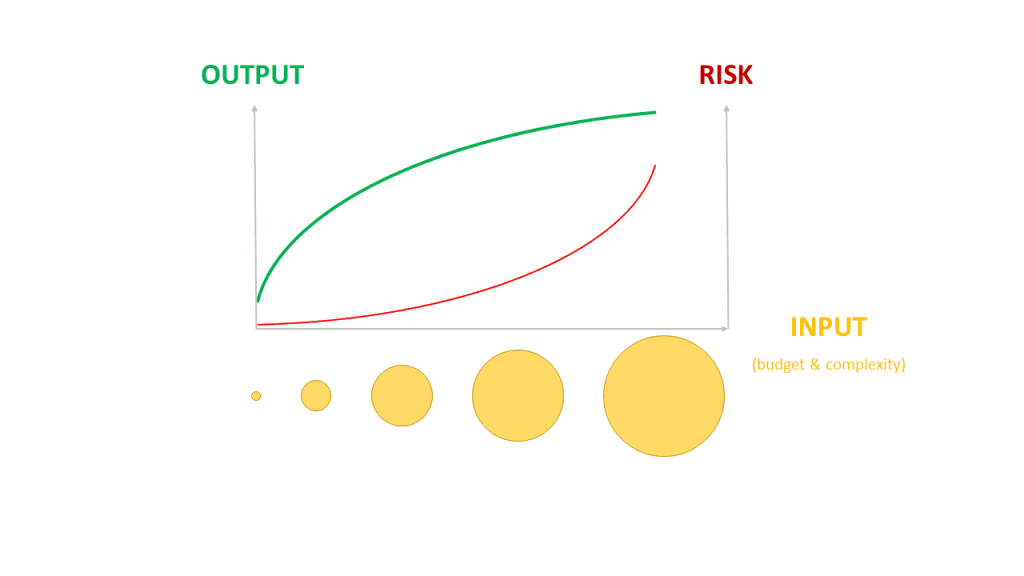In a typical water-scarce river basin, there is a practical contradiction in water resources management. It is concerned with the tradeoff between cumulative output and required input—in terms of budget & management capacity. Risks are also part of the tradeoff.
It is evident that pressure on water resources is increasing to unprecedented levels because of population growth, food security concerns, and socio-economic development. A common response is to strive for optimizing the beneficial use of these water resources in order to satisfy diverse socio-economic and environmental needs. It would require a sophisticated and complex management system that considers the interests of a wide spectrum of stakeholders while maximizing the productive use of every drop of water. Sounds desirable—right?
Yet it is equally clear that the budgetary resources needed to sustain this level of management complexity are not available.
One can argue that budgets for water agencies should increase. But governments face huge competition for public funds and need to find the right balance among many priorities: education, health care, sanitation, roads, rural electrification, agricultural modernization, pensions, security, debt servicing, and others. Thus—despite the best of intentions—it is unlikely that many governments can make a long-term commitment to a progressively increasing budget for water resources management.
Moreover, evermore water scarcity requires evermore complex management systems, which are ever more expensive. In addition, there are risks associated with complexity and optimization.
So, what to do? Or phrased more formally: when is expanding the capacity for water resources management the right (or wrong) strategy?
It is worthwhile to examine history.
Joseph Tainter (1988) has identified a template for the collapse of complex societies, which is applicable to the question of what level of managerial complexity is desirable. It is based on four concepts—which have been adapted in this text to water resources management:
- water agencies are problem-solving organizations (such as avoiding water conflicts)
- water management requires public funds
- increased complexity carries with it increased costs, and
- investments in managerial complexity as a problem-solving mechanism often reaches a point of declining marginal returns.
This process is illustrated in the below figure.

A few observations:
- More complex systems require more: data & information, hierarchy, decisions, communication, agreement, collaboration, centralization, rules & regulations, specialists, etc.
- More complex systems require more physical infrastructure
- Growth in complexity tends to be exponential
- Thus, managing a more complex system requires resources at a vastly greater scale—in terms of budget, skilled people, management & information systems, etc.
- If these resources are not there, the system will stop functioning; this can either lead to full collapse, or a reversal to a less complex system with much lower output; either way, system failure will have adverse socio-economic consequences—with possible political implications
- With more complexity, risks increase exponentially because of the many linkages among system elements, and because redundancies (previously called ‘waste’) have been eliminated; the impacts of sub-system failure in a highly interlinked system amplify; the system becomes vulnerable to minor disturbances and is fragile

- Increasing complexity serves ever narrowing segments of the system, at ever greater costs
- At the end point of the continuum, a further increase of complexity—at prohibitive costs—will only marginally increase cumulative output
The above does not suggest that increasing complexity has no benefits. Rather, it raises the question if a society can muster the required resources to sustain this level of complexity, and—equally important—if it can deal with the consequences of system failure in the absence of these resources.
Primum non nocere (first do no harm)
It points to a key guiding principle: “first do no harm”. Very often, water resources management is not about system optimization, but about avoiding something at all costs—for instance crop failure, or loss of life or critical infrastructure due to flooding. Thus, for countries with budgetary constraints, it is evident that the more advanced stages of the complexity spectrum should be avoided—at least for now.
A few (conceptual) recommendations:
- Management complexity, system complexity, and associated resources must evolve in harmony
- Develop a management system that can be comfortably maintained with the available (local) resources; donor funds should not be included in this assessment
- Always assess the potential losses in case system complexity cannot be maintained
Practical examples of this approach—for flood management and for management of small rural catchments—have been discussed on this blog.
(with thanks to Joseph Tainter, the Collapse of Complex Societies, 1988)
Increasing system complexity: a narrative.
In the initial stage, populations are small and natural resources—in terms of land and water—are abundant. Fallow cultivation maintains soil fertility and leads to reasonable yields. Rainfed agriculture dominates and demand for water resources is minute. A collection of small-scale and independent farms produces sufficient output to feed the population. The managerial capacity needed to run this system is minimal, and risks are mitigated through traditional coping mechanisms. Systemic risks are low.
In a subsequent phase, a growing population requires more food. Agriculture is intensifying and the best lands are in use. Marginal lands are progressively being occupied and the time between harvest and next planting is the only fallow period. Yields of rainfed farming systems are decreasing. Irrigation is being introduced but water demand for other productive sectors is still minimal. Competition over water resources and land is local. The system can be managed by existing governance structures and does not require dedicated professionals. Systemic risks remain low.
Water resources are fully allocated at the next point on the continuum. Agriculture remains the dominant water user but demand from other productive sectors is rising and no longer negligible. Agricultural yields are high and depend on secure water supply in combination with high levels of agricultural inputs. Failure to timely deliver water will result in crop failure. The system is managed by a dedicated bureaucracy of professional resource managers and technicians. It is paid for by a tax on agricultural produce. Farmers complain and think the tax is too high—but what can they do?
At the end of the spectrum, the productive use of water resources is optimized through a very sophisticated system that allocates water to activities with the highest monetary output. All waste in the systems has been eliminated. Water management is based on real-time monitoring of all hydrometric parameters in combination with satellite imageries and a set of detailed and interlinked models with optimization routines and forecasting modules. It provides up-to-date and detailed geo-referenced information on the state of all components of the water cycle and the associated productive uses. This extraordinarily complex system is run by a cadre of highly qualified professionals. Substantial government budgets are allocated to water resources management. Systemic risks are high. If the system fails, all is lost.
